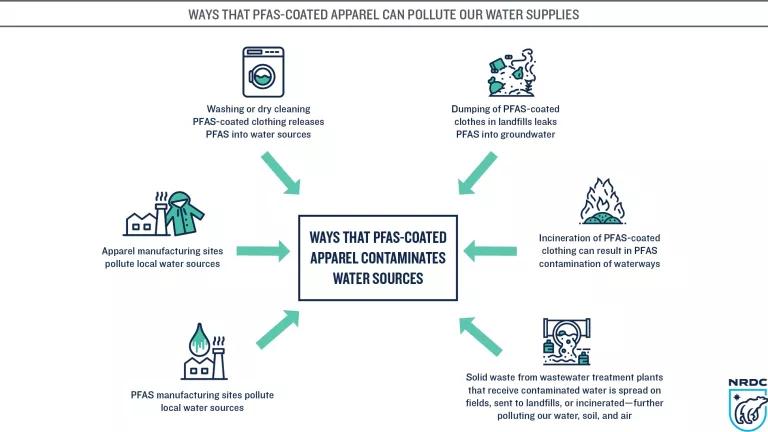CA Legislature Turning Off Tap on PFAS “Forever” Chemicals
The end of the legislative session in California brought welcome news on PFAS, a class of toxic “forever” chemicals consisting of 12,000+ chemicals. Several pieces of legislation addressing this toxic and persistent class of chemicals moved forward.

The end of the legislative session in California brought welcome news on PFAS, a class of toxic “forever” chemicals consisting of 12,000+ chemicals. Several pieces of legislation addressing this toxic and persistent class of chemicals moved forward.
PFAS contaminate drinking water across the state and country, particularly in disadvantaged communities; are showing up in rainwater and sea spray; and are found in the bodies of virtually all people living in the US. They are associated with myriad health effects, including cancer, liver and kidney damage, and suppressed immunity, including interference with the effectiveness of vaccines. Not surprisingly, Californians across the spectrum overwhelmingly support getting PFAS out of everyday products like clothes and textiles.
The California Legislature is delivering for its residents. The Legislature passed several bills to eliminate unnecessary uses of PFAS in products (including clothes and textiles and cosmetics) and to create greater information and transparency on the presence of PFAS in products and industrial processes. These bills are now on the Governor’s desk. The Legislature also provided funding for improved testing and the development of health-based standards for PFAS in drinking water. These efforts put California at the forefront of state and national actions across the country to address PFAS pollution and protect residents in the absence of comprehensive national action and can even help transform the national market when it comes to the use of PFAS.
Funds to address PFAS in drinking water
Earlier in the summer, California’s budget authorized funds to support the State Water Board in addressing this massive class of chemicals broadly, and not just one at a time, by:
- conducting additional PFAS monitoring, particularly for disadvantaged communities;
- developing a validated broad-spectrum test for the class of PFAS chemicals; and
- developing a treatment technique for addressing total PFAS.
We and our allies at Clean Water Action and Community Water Center are working with the State Water Board to follow up.
Bill to phase out of PFAS in clothes and textiles
AB 1817 (Ting), the Safer Clothes and Textiles Act, would ban the use of PFAS in most clothes and textiles starting in January 2025. This affects clothes (including outdoor apparel), footwear, household textiles such as sheets and towels, handbags, backpacks, furnishings and upholstery, including textile-based outdoor furniture, shower curtains, and a host of other products in our homes and businesses. Personal protective equipment, which may be needed for health and safety and are used in settings such as healthcare and firefighting, would not be affected by the ban.
Furthermore, while outdoor apparel for severe wet conditions, which are not marketed to the general consumer and are designed for outdoor sports experts, would have until January 2028 to phase out PFAS, any such products containing the chemicals that are sold between 2025 and 2028 would have to disclose that they are “Made with PFAS chemicals,” including on online listings.
The bill is co-sponsored by NRDC, Breast Cancer Prevention Partners, and Clean Water Action, and has support from companies and entities that are leading on eliminating PFAS from clothing and textile products, such as Patagonia, Ikea, Maharam, and the California Outdoor Recreation Partnership.
Other bills addressing PFAS
The Legislature also passed bills banning PFAS in cosmetics (AB 2771) and requiring the reporting of all PFAS being brought into the state whether in products or for manufacturing (AB 2247). These are both important bills led by our allies that NRDC also supports.
While the Legislature and state regulators have taken, and continue to take, important actions to reduce PFAS use and exposures, the ubiquitous nature of these chemicals means we are blind to many other exposure routes, especially in California where we do not manufacture PFAS. For this reason, the reporting bill is critical for knowing where PFAS are being used and where exposures and threats to water resources may occur.
The bills phasing out the use of PFAS in clothes and textiles and in cosmetics build on previous action by the Legislature to ban PFAS in firefighting foam, paper-based food packaging, and children’s products. Ending existing uses of PFAS is critical. Studies show that phasing out the use of certain PFAS reduces exposure to these chemicals. In addition, PFAS are costly and energy intensive to clean up, treatment cannot fully reverse the damage inflicted on public health and the environment, and we haven’t yet developed ways to safely dispose of PFAS waste. The best way to protect the public and environment from PFAS exposure and harm is to stop the production and use of PFAS wherever possible. California’s large market means that action by the state will not only protect residents, but can help transform the national market for these products.
Action by many other states, including New York, which recently passed a bill to ban PFAS in everyday apparel and is considering broader legislation, and Maryland, which banned PFAS in firefighting foam, rugs and carpets, and paper-based food packaging, are adding to the momentum.
We hope that Governor Newsom will sign AB 1817, AB 2771, and AB 2247, and help protect the health and environment of Californians and beyond.




